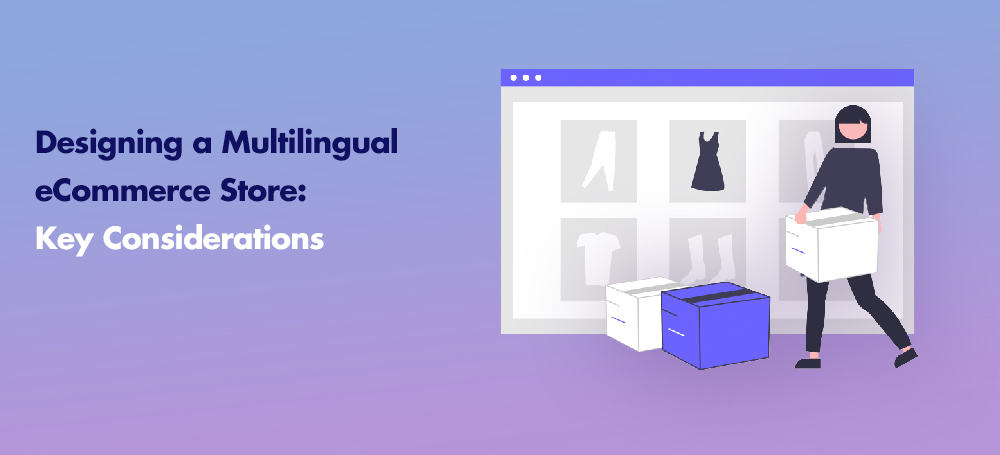

Designing a Multilingual eCommerce Store: Key Considerations in 2023
In the age of the internet, businesses that tap into the global market have access to wider customer bases. This means that providing a multilingual eCommerce store is essential for connecting with customers all over the world.
However, creating a website that can handle multiple languages can be a difficult task. It involves more than just translating your existing content; a full-fledged website design needs to be built that can handle a wide range of languages. In this blog post, we will discuss the key considerations for designing a multilingual eCommerce store. We will delve into the technical aspects of designing a website that can handle multiple languages and look at the different strategies for rolling out a multilingual store. Finally, we’ll cover some of the best practices to ensure success. With this post, you should have all the information you need to get started on building a multilingual eCommerce store.
1. Research the target markets and languages for the store
When designing a multilingual eCommerce store, researching target markets and languages is essential to ensure an enjoyable user experience. Knowing which languages and markets the store will serve will give key insights into the cultural and linguistic requirements of the user interface and user experience. Additionally, research allows for identification of any potential regional differences in user experience, such as payment and shipping preferences, as well as applicable international laws and regulations. Investing the time in researching target markets and languages upfront will ensure a successful multilingual eCommerce store.
2. Consider the best platform for a multilingual store
When designing a multilingual eCommerce store, one of the most important considerations is choosing the right platform. Having a platform that is specifically designed to support multilingual eCommerce is essential for creating a good user experience. It should offer the ability to translate customer-facing content, such as product descriptions and customer service information, into multiple languages. The platform should also be able to support a range of currencies and payment methods, as well as providing an intuitive user interface and easy navigation. By choosing the right platform, you can ensure that your multilingual eCommerce store has everything it needs to provide a quality customer experience.
3. Determine the best localization strategy
When designing a multilingual eCommerce store, it is important to determine the best localization strategy. Localization can help improve user experience and user interface, while also making it easier for customers to use the online store. Depending on the size of the store, it might be best to start with a few target languages and then expand over time. To ensure optimal localization, it’s important to consider the cultural differences between languages and regions. This means researching the target demographic and ensuring that the eCommerce store is tailored to their needs and preferences. Additionally, the multilingual eCommerce store should be optimized for search engines in all target languages. Doing this can help increase traffic and boost sales.
4. Develop a product naming strategy
When designing a multilingual eCommerce store, it is important to develop a product naming strategy that ensures a consistent user experience across multiple languages. This can be done by creating a naming convention and naming system that is shared across languages. Such a system should be tailored to the user interface and user experience of the store, taking into account the differences between languages, such as word length and phonetic distinctions. Additionally, product names should be kept as simple and intuitive as possible in order to ensure that users are not confused or put off by unfamiliar words.
5. Factor in currency conversions
When designing a multilingual eCommerce store, it is important to factor in currency conversions. As customers from around the world will be accessing your store, prices may need to be presented in different currencies. Depending on your target market, you will need to decide which currencies should be supported. It is also important to ensure that the eCommerce platform you use has the capability to convert prices into other currencies. Additionally, when it comes to user experience and user interface, it is important to ensure that customers can easily select the currency they would like to pay in. This will help to provide a better overall experience for customers.
6. Provide customer service in multiple languages
When designing a multilingual eCommerce store, one of the most important considerations is to ensure customers can receive customer service in their preferred language. Providing customer service in multiple languages not only improves user experience and user interface, but it also enables customers to more fully engage with the eCommerce platform. When customers can communicate in their native language, they can more easily discuss their queries, orders, and any other issues they may encounter. It’s also helpful to provide customer service in multiple languages to ensure customers feel heard and their needs are met. Additionally, providing customer service in multiple languages also helps to build trust, which is key in order to foster relationships with customers.
7. Incorporate a translation management system
The seventh crucial step when designing a multilingual eCommerce store is to incorporate a translation management system. This system allows stores to manage the translations of their product pages, descriptions, and other content, so that each language is presented in a consistent and correct manner. This is important for ensuring a good user experience as well as for accurately representing the eCommerce store. Additionally, this system should include features such as a user interface for translating content, validation of translations, and workflow management. These features all contribute to a comprehensive, efficient, and accurate translation process.
8. Monitor and adjust the localization strategy as needed
It’s important to monitor and adjust your localization strategy as needed for optimal user experience. Make sure your multilingual ecommerce store is designed for users to navigate quickly and easily in their native language, with language-appropriate user interfaces. Analyze user feedback and monitor user engagement to identify how changes in language or design may affect user experience. Adjust your localization strategy as needed to ensure users are getting the most out of your ecommerce store.
In summary, creating a multilingual eCommerce store can be a great way to open up your business to a wider audience. However, it is important to consider the key elements of design when taking this step. Factors such as language selection, website navigation, payment methods, and cultural sensitivities should all be taken into account. With careful planning and attention to detail, you can create a successful multilingual store that will appeal to customers from all over the world.
Roars Technologies is committed to delivering excellent ecommerce website development services to those who aim to impact their industry and form stronger connections with their customers. Let us discuss how we can create your next ecommerce store.

